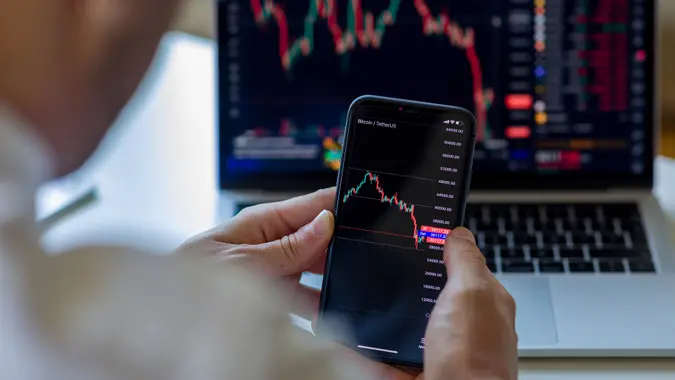5 Best Gold ETFs To Watch and Invest In for 2025

Commitment to Our Readers
GOBankingRates' editorial team is committed to bringing you unbiased reviews and information. We use data-driven methodologies to evaluate financial products and services - our reviews and ratings are not influenced by advertisers. You can read more about our editorial guidelines and our products and services review methodology.

20 Years
Helping You Live Richer

Reviewed
by Experts

Trusted by
Millions of Readers
Gold has always been a desirable investment, but the idea of handling, storing and protecting actual gold bars or coins can seem burdensome for many. This is where gold ETFs provide a solution. They allow investors to access the gold market without having to take actual possession of bullion.
But is investing in a gold ETF the right way to go? Here’s a look at how gold ETFs work and which ones might be good choices for the rest of 2025.
5 Best Gold ETFs To Invest In
Here are the five best gold ETFs to invest in, based on a combination of size, liquidity, performance and expense ratio.
| ETF | Ticker | Expense Ratio | 1-Year Return |
|---|---|---|---|
| SPDR Gold Shares | (GLD) | 0.40% | 34.43% |
| iShares Gold Trust Micro | (IAUM) | 0.09% | 34.89% |
| VanEck Merk Gold Trust | (OUNZ) | 0.25% | 34.69% |
| Goldman Sachs Physical Gold | (AAAU) | 0.18% | 34.62% |
| Sprott Physical Gold Trust | (PHYS) | 0.41% | 34.19% |
1. SPDR Gold Shares (GLD)
The SPDR Gold Shares ETF was the first gold-backed ETF, and it’s still by far the largest in terms of net assets, with more than double the assets of the second-largest ETF.
- The design of the ETF is straightforward — it buys gold bullion stored in secure vaults, and its net asset value tracks the price of gold itself.
- It’s one of the most popular and liquid gold ETFs.
- One of the only drawbacks of GLD is its relatively high expense ratio of 0.40%.
2. iShares Gold Trust Micro (IAUM)
IAUM offers a cost-effective alternative to larger gold ETFs like GLD, making it appealing for long-term retail investors.
- Structured similarly to GLD but with a lower share price.
- The expense ratio is just 0.09%.
- GLD is more liquid due to its size, which is beneficial mostly for large or institutional trackers.
- For average investors who plan to buy and hold, IAUM may be the smarter choice.
3. VanEck Merk Gold Trust (OUNZ)
OUNZ is another gold bullion ETF, but it holds its assets in the form of allocated London Bars.
- Unlike many other gold ETFs, OUNZ offers investors the ability to exchange their shares for actual physical delivery of gold coins and bars, giving it flexibility for investors.
- This flexibility adds appeal for those who may want to actually hold their gold instead of just a paper asset.
4. Goldman Sachs Physical Gold (AAAU)
AAAU gives investors exposure to physical gold through shares that track the metal’s price, minus trust expenses.
- Designed to reflect the price of gold, less operating costs.
- While it holds physical gold, it doesn’t offer the exchange feature that OUNZ does.
- It carries a low expense ratio of 0.18%.
5. Sprott Physical Gold Trust (PHYS)
The Sprott Physical Gold Trust offers a straightforward way to invest in gold, backed by physical bullion.
- Fully or nearly fully invested in physical gold.
- Allows redemption of shares for physical gold.
- Offers secure storage and high liquidity.
- Has a low expense ratio of 0.41%.
Why Invest In Gold ETFs?
No investment comes without risks, but investing in gold or gold ETFs is considered by some experts to be a safe haven investment.
- During times of economic instability, the value of gold tends to increase as stock market prices take a tumble and investors look for a safer place for their money.
- The best gold ETFs are popular because buying physical gold can be cumbersome. In addition to picking the type of gold, you’ll have to take delivery of it and store it. You might also face markups and storage fees.
- Physical gold is also much more illiquid than a gold ETF. You’d have to take it to a dealer and shop around for a good price, rather than selling it instantly on an exchange at the current market price, typically for no commission.
- While you don’t technically own gold shares if you buy an exchange-traded fund, some ETFs actually offer the ability to take delivery of physical gold, if you so desire. This has both advantages and disadvantages, so it’s important to know what you’re getting into if you choose to go that route.
Good To Know
Experts recommend that you use gold strategically, to diversify your portfolio, rather than as a core holding.
Consider limiting commodities investments, including gold ETFs, to 5% to 15% of your portfolio.
Gold ETFs vs. Other Investment Options
Gold ETFs might not be the best asset type to add to your portfolio. Consider other ways to invest in gold as well as alternative investments.
- Gold stocks:
- Stocks in gold mining companies and other companies involved with gold give you indirect exposure and potentially better returns.
- Bitcoin:
- Bitcoin is a more speculative and volatile investment than gold, and it correlates more with the stock market. If you want an alternative investment, consider allocating a small portion of your portfolio to it, whether by purchasing Bitcoin or investing through a Bitcoin ETF.
- Real estate investment trusts:
- REITS are an indirect way to invest in real estate. Trusts purchase and operate investment properties and/or invest in mortgage debt. They’re less effective at diversifying your portfolio but are less volatile and usually produce dividends.
Here’s a summary of how gold compares to alternative investments.
| Characteristic | Gold ETFs | Gold Stocks | Bitcoin | REITs |
|---|---|---|---|---|
| Diversification Potential | Good | Low | Low | Moderate |
| Volatility | Very high | High | Extremely high | Moderate |
| Dividends | Not unless fund invests in assets other than gold | Sometimes | No | Yes |
| Inflation Hedge | Yes | Possibly | Possibly | Yes |
Risks of Investing in Gold ETFs
Investing in gold has drawbacks you should consider.
- Gold doesn’t generate income:
- Gold doesn’t pay a dividend, create jobs or earn revenue.
- Warren Buffett famously avoids gold for this reason — it only gains value if someone is willing to pay more than you did.
- That makes future value hard to predict.
- Price volatility:
- Gold prices often rise with inflation, which makes it attractive during economic uncertainty.
- But when inflation drops, investors may shift back to stocks, pushing gold prices down.
- No built-in growth:
- Gold is a physical object that doesn’t produce income.
- Unless the ETF also invests in yield-generating assets, such as Treasurys, you rely 100% on price appreciation.
- Tax treatment:
- Gold ETFs backed by physical bullion are taxed as collectibles by the IRS.
- Long-term capital gains may be taxed at up to 28%, rather than the standard 20% rate for stock profits.
Trends Shaping Gold Prices in 2025
Gold prices have hit over a dozen record highs so far in 2025, according to CNBC.
Although prices had been trending generally upwards since last summer, they took off in the early days of President Donald Trump’s administration. The administration’s tariff announcements — both regarding the imposition of tariffs and their on-again-off-again rollout — have roiled markets and created uncertainty among investors, driving investors to gold.
Experts’ opinions are mixed on whether gold prices are nearing a ceiling or have further to go.
How To Buy Gold ETFs: 4-Step Guide
ETFs trade in much the same way as stocks. Here’s how to invest:
- Select a brokerage platform and then register and fund your trading account.
- Use your broker’s ETF screener to identify gold ETFs.
- Research the ETFs you’re interested in investing in using the fund information on the brokerage site as well as financial news reports.
- When you’re ready to buy, call up the ETF you want to invest in and select the “buy” button.
FAQ
Here are the answers to some commonly asked questions about gold ETFs.- What are the best gold ETFs for beginners?
- Any of the ETFs listed in this roundup are suitable for beginning investors.
- Should I invest in gold ETFs in 2025?
- That depends on your investment goals, your current holdings and your risk tolerance.
- Gold prices are currently near record highs, but the economic uncertainty driving them up is ongoing. And because gold is volatile, it's best to keep your allocation low.
- Which gold ETFs pay dividends?
- Gold ETFs typically don't pay dividends. Physical gold doesn't produce yields, so the ETF would need to invest in additional, income-producing assets.
- Are gold ETFs good for long-term growth?
- They can be. No one can predict what the gold market will do short or long term, but historically, gold has risen over the long term despite significant fluctuations in price.
Caitlyn Moorhead and John Csiszar contributed to the reporting for this article.
Information was compiled on April 15, 2025, and is subject to change.
Our in-house research team and on-site financial experts work together to create content that’s accurate, impartial, and up to date. We fact-check every single statistic, quote and fact using trusted primary resources to make sure the information we provide is correct. You can learn more about GOBankingRates’ processes and standards in our editorial policy.
- Macrotrends. "Historical Gold Prices - 100 Year Chart."
- VanEck. "VanEck Merk Gold Trust ETF - Fact Sheet."
- VanEck. "VanEck Merk Gold Trust ETF Overview."
- CBS News. 2024. "1-ounce gold bar alternatives: 5 other gold investments to consider this June."
- Morningstar. 2025. "How to Use Commodities in Your Portfolio."
- IG. "What are safe-haven assets and how do you trade them?"
- Sortis Capital. 2024. "REITs v/s Other Financial Instruments."
- CNBC. 2025. "Is now a good time to buy gold? Here’s what you need to know."
- Barron's. 2023. "Gold Is Rallying. Here’s How to Play It for Income."
 Written by
Written by  Edited by
Edited by 

























